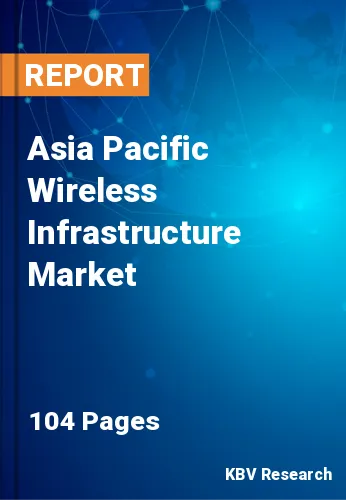
The Asia Pacific Wireless Infrastructure Market would witness market growth of 10.0% CAGR during the forecast period (2022-2028).
The access point, which connects the wireless radio frequency, is the point of communication for all mobile and wireless client devices and computers when in infrastructure mode. The 802.11 packets are converted to 802.3 Ethernet LAN packets by the access point. The access point transforms data packets from the LAN to a wireless client into radio signals before disseminating them throughout the surrounding area.
Any nearby wireless clients and gadgets can receive the packets, but only clients with the right destination address will do so and process the data. A Basic Service Set is a simple wireless network with one access point (BSS). A single sub-network formed by multiple access points connecting to a network is called an Extended Service Set (ESS). The 802.11 specification has roaming features that let a client computer move between several access points on various channels.
As a result, roaming client devices that receive poor signals can connect to other access points that receive stronger signals. Client workstation networking loads can also be better balanced by deploying many access points to cover the same area and by using various non-overlapping frequencies. Because of excessive strain on its present access point, a wireless LAN NIC may choose to "reassociate" with another access point within range. The performance of the entire network may benefit from these features.
New information infrastructure, infrastructure connected to innovation, and integrated/fused infrastructure are the three additional primary sectors that the National Development and Reform Commission (NDRC) proposes will comprise new infrastructure. Expanding the distribution of broadband services to more remote locations will be made possible by additional data centers, industrial internet capacity, artificial intelligence (AI), the Internet of Things (IoT), and satellite-delivered internet services. Blockchain is part of the new infrastructure. Senior Chinese officials have taken a particular interest in blockchain, where the technology has few entry barriers, and Chinese enterprises may play a significant role. Thus, the adoption of 5G and its related services, as well as changing infrastructure in the nations, would propel the growth of the wireless infrastructure market in the Asia Pacific.
The China market dominated the Asia Pacific Wireless Infrastructure Market by Country in 2021, and would continue to be a dominant market till 2028; thereby, achieving a market value of $25,349 Million by 2028. The Japan market is estimated to grow a CAGR of 9.2% during (2022 - 2028). Additionally, The India market would experience a CAGR of 10.5% during (2022 - 2028).
Based on Infrastructure, the market is segmented into Distributed Area Network, Mobile Core, Radio Access Network, Small & Macro cells, and SATCOM. Based on Platform, the market is segmented into Commercial, Defense, and Government. Based on Type, the market is segmented into 4G, 5G, 2G & 3G, and Satellite. Based on countries, the market is segmented into China, Japan, India, South Korea, Singapore, Australia, and Rest of Asia Pacific.
Free Valuable Insights: The Worldwide Wireless Infrastructure Market is Projected to reach USD 259.3 Billion by 2028, at a CAGR of 9.5%
The market research report covers the analysis of key stake holders of the market. Key companies profiled in the report include Qualcomm Inc. (Qualcomm Technologies, Inc.), Capgemini SE, D-Link Corporation, ZTE Corporation, Huawei Technologies Co., Ltd. (Huawei Investment & Holding Co., Ltd.), NXP Semiconductors N.V., Cisco Systems, Inc., Fujitsu Limited, NEC Corporation, and Ciena Corporation.
By Infrastructure
By Platform
By Type
By Country
Our team of dedicated experts can provide you with attractive expansion opportunities for your business.
